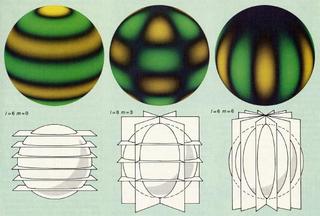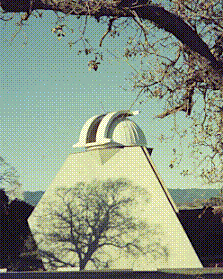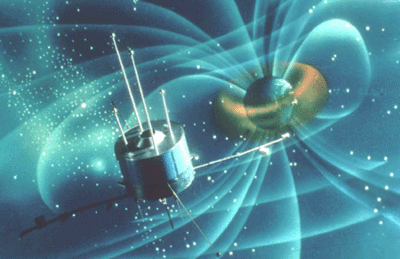Podcasting the sun

[Image: Helioseismology, or earthquakes on the sun (because "Sunquakes" would sound too much like a breakfast cereal...)]
"Have you ever wondered," the Stanford-Lockheed Institute for Space Research asks, "what the Sun would sound like if you could hear it?" Why yes.
Luckily, you can now listen to "sun sounds," courtesy of the SOHO Michelson Doppler Imager (MDI) project, "part of an international collaboration to study the interior structure and dynamics of the Sun" – including what the sun sounds like.

[Image: Computer simulation of the sun's convective interior]
As you probably know, "the Sun is essentially spherical" – but this also means that it "forms a spherical acoustical resonator with millions of different normal modes of oscillation. Due to the waves' long life times, destructive interference filters out all but the resonant frequencies, transforming the random convective noise into a very rich line spectrum in the five-minute range. Thus, convection acts rather like a random clapper causing the Sun to ring like a bell."
To measure these oscillations – indeed, to listen to the sun "ring[ing] like a bell" – a whole new kind of densely connected, architectural network is required: "an uneclipsed instrument in space, observatories at the Earth's poles, and a network of observatories around the Earth."
All of these, of course, would need unimpeded sonic access to the solar "clapping."

[Image: The Wilcox Solar Observatory]
The sun can be listened to indirectly, of course, in the form of solar storms interfering with terrestrial radio and television broadcasts – which brings to mind the story of how radio astronomy was first discovered, at Bell Labs in New Jersey. Thinking that his antenna was generating its own heat and noise, and therefore interfering with the experiment at hand (which I believe had something to do with telephones: discovering the universe by telephone), Karl Jansky eventually realized that all that white noise was *coming from deep space* – it was the sound of stars – and that he had discovered the radio-noise background in which our entire universe hums, eternally, at every second of every day, a kind of quiet hiss or whisper that we now know is an omnipresent sonic fossil left over from the Big Bang.
Space is full of sounds.
It was reported by Reuters, for instance, almost exactly two years ago, that a "particularly monstrous black hole has probably been humming B-flat for billions of years, but at a pitch no human could hear, let alone sing" – and that scientists "believe it is the deepest note ever detected in the universe."
"As the black hole pulls material in, [Andrew Fabian of the Institute of Astronomy at Cambridge, England] said, it also creates jets of material shooting out above and below it, and it is these powerful jets that create the pressure that creates the sound waves."
Seismology in B-flat.
Or – similarly, about two years ago – the consistently exciting magazine New Scientist revealed that the Big Bang sounded "rather like a large jet plane flying 100 feet above your house in the middle of the night": "Giant sound waves propagated through the blazing hot matter that filled the Universe shortly after the Big Bang. These squeezed and stretched matter, heating the compressed regions and cooling the rarefied ones. Even though the Universe has been expanding and cooling ever since, the sound waves have left their imprint as temperature variations on the afterglow of the big bang fireball, the so-called cosmic microwave background."
Enter Karl Jansky and his broken telephone, throw in some helioseismology – and you get landscapes of noise, in deep space.
(For some gorgeous MP3s of global shortwave radio music, full of radio hiss and strange sidereal cross-broadcasts – the sun whispering to itself, drenched in light – see the blog ShortWaveMusic; and for another post on a similar theme, see Radio Haloes of Earth).

[Image: This is actually a satellite measuring the earth's magnetic field, but...]





Comments are moderated.
If it's not spam, it will appear here shortly!
Aww. Thanks for the plug (and great description). I've posted about your blog in my personal (non-shortwave) blog and will be adding a link from my homepage. Keep up the almost intimidatingly sharp work.
Post a Comment